Compression socks can be worn by anyone, but older individuals are more likely to benefit from them than anyone else.
In fact, upon hearing the term ‘compression socks,’ the first image in your mind is likely an older person putting on a pair!
With that in mind, this post talks about the best compression socks for elderly.
As people age, it is normal for them to experience changes in lifestyle.
Their health may also steadily deteriorate, and some people start to lose the physiological and psychological strengths they possessed in their youth.
As this happens, they become more prone to a variety of chronic diseases and health issues, such as diabetes, high blood pressure, cardiovascular diseases, depression, arthritis, and circulatory problems.
Whether they live at home or at a senior care facility, the elderly require regular care and personalized routines if they are to successfully combat the health issues outlined above.
One way to do so is by using compression socks.
Compression socks can provide anyone who uses them with support and comfort for their limbs.
Doctors and senior citizen homes recommend the use of compression stockings as standard when it comes to proper care for the elderly.

What are compression socks?
Compression socks are stretchable, elastic socks that cover your legs, feet, and ankles. They use flexible materials that apply constant pressure on your limbs. That is why they are sometimes called pressure socks.
Graduated compression stockings were originally popular during pregnancy. (Pregnancy causes legs to swell like crazy) The risk of blood clot in the legs is increased during several medical conditions, so they were soon used for prevention of deep vein thrombosis and venous insufficiency.
Compression socks come in a wide range of shapes, sizes, lengths, and compression levels, and they are different from regular socks because the pressure they apply on your legs helps to support the movement of your ankles and feet. This pressure is also effective in the prevention and control of various venous disorders, circulatory issues, and edema.
You will commonly see graduated compression socks used by diabetics to improve blood flow and lower the risk of a blood clot. They are available over the counter (you can read customer reviews and buy them online here) so for swollen legs they are the first line of budget home car to consider.
How do compression socks work?
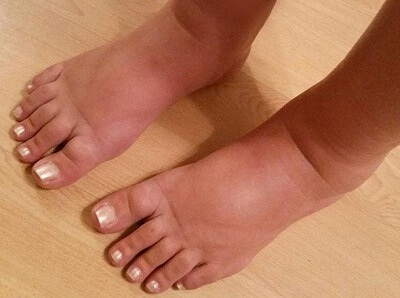
Compression stockings are used in compression therapy and they can help lower and even prevent edema, swollen feet, circulatory issues, and venous deficiencies. Compression therapy is an old and proven approach to physical rehabilitation and it has long been part of the rehab regimen of senior clinics, maternity hospitals, and assisted living communities.
The basic function of compression hosiery is to apply pressure around the limb of the user, but some people may still ask whether this is of any use. The answer lies in the fact that pressure of this type can help the circulatory system as it supports the walls and valves of the veins in the legs.
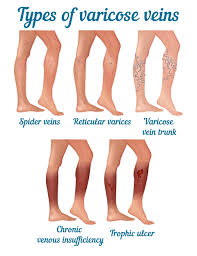
Edema, blood clotting, varicose veins, spider veins, deep vein thrombosis, and in some cases, leg ulcers are caused by reduced blood flow in the legs, as well as a leg injury, cardiovascular diseases, aging, a general lack of movement, and even smoking.
Warning: It’s true that compression socks can help your lower leg health. While we provide basic information, this is not the same as medicine guidance from a doctor. We recommend speaking to your doctor to help choose the best compression socks, especially if you’re using them for recovery after surgery.
Compression socks apply pressure to the ankles of the wearer. This pressure gradually falls as the hose extends upward toward the knee or thigh. In this way, compression socks squeeze the veins in the feet and legs and prevent the accumulation of blood in the lower regions of your limbs, promoting healthier blood circulation. When deoxygenated blood leaves the legs more quickly, fresh, nutrient-rich blood takes its place. This helps prevent the development of swollen feet and the pooling of body fluids (mostly blood and lymph) in the feet and legs.
Benefits of wearing compression socks for seniors
Adjusting to old age, especially after the age of sixty, can be tough. The constant care and assistance that you now need for tasks and activities that you used to perform on your own can take a serious toll on your physical and psychological well-being. You may find yourself becoming tired more easily, losing stamina quickly, and suffering from chronic pain more frequently. To live a happy and content life, it is of utmost importance that you find simple yet effective ways that can help you maintain your quality of life, and compression socks are a simple yet effective way to do just that.
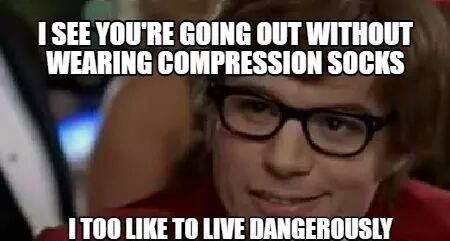
Here are some of the health benefits that you will enjoy once you start using compression gear in your daily routine.
Edema and swollen feet
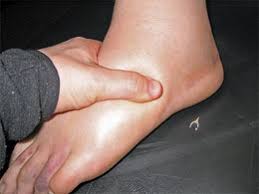
Edema and swelling are more common in the elderly since their movements are restricted. This can be because of arthritis, joint pain, or other health problems, and the likelihood of fluid accumulation in the limbs increases exponentially as a result. Compression socks can help reduce edema and fight the painful heaviness and swelling that accompany fluid accumulation in the legs.
Pain reduction

One of the biggest challenges that the elderly face is the inability to move freely and being unable to perform routine activities and the things they enjoy themselves. Leg pain can pose a significant challenge to free movement and it presents a psychological barrier to a healthy life as well.
Compression socks are a safe remedy for the mitigation of leg pain and chronic tiredness. Leg heaviness can sometimes become so painful that the victim cannot even walk or perform their day to day activities on their own. Oral medications for pain are sometimes out of the question as well for such individuals because of their age. Under such circumstances, compression and support garments can reduce the pain in the patient’s limbs and provide them with relief with almost no side-effects.
Important: Always consult your doctor about any leg pain you have. Doctors are experts in keeping your whole body healthy. It’s worth it to spend the time to have a doctor make sure you don’t have an underlying condition that could be life threatening.
Medical conditions and leg disorders

Old age brings with it new illnesses, and it aggravates old conditions as well. Common conditions faced by the elderly include deep vein thrombosis (DVT), chronic venous insufficiency (CVI), leg ulcers, varicose or spider veins, lymphedema, circulatory issues, and blood clotting. Compression stockings prevent, reduce, and control the progression of such disorders. They work best when the correct compression level is used regularly alongside other prescribed medications and treatments.
Lower leg compression can be a working natural treatment for many conditions.
Recovering from surgery

The older we get, the higher are our risks of severe illnesses and, consequently, surgeries. Post-surgical recovery is longer and harder for patients above the age of fifty. Doctors recommend compression stockings for patients recovering from surgeries. Compression gently assists blood in your lower leg to return back to your heart.
Protection of your feet and ankles
The above image is similar to sock soothers for seniors, a common scam that should be avoided. Customers quickly realize that this fancy foot glove toe sock isn’t the beauty they expected. It’s either too small or too large.
It takes longer for seniors and the elderly to heal their wounds, and they are more susceptible to infections as well. Diabetes is another huge concern for people who cross their fifties. Slow-healing and nerve damage due to diabetes further increase the importance of foot care for the elderly. Compression socks can safeguard against minor cuts, injuries, and mosquito bites, and they can help prevent infection to some degree as well. Thigh-high compression socks can even be used to provide additional protection against harsh environments such as cold weather.
General well-being
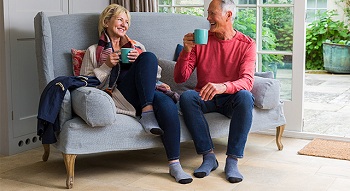
Compression socks help the elderly carry out their regular activities with ease by promoting mobility and reducing pain. Being unable to work, go to the restroom, and even walk down to the curb can lead to frustration and can also lead to depression and anxiety in extreme cases.
Side effects of support hose for the elderly

Support garments are generally a safe prevention remedy and can provide care for injuries. They are few if any known side-effects on users. however, in the case of seniors, extra care is necessary to prevent any unforeseen or harmful effects of the socks which may arise as a result of the incorrect use or abuse of the socks. Harmful effects that may appear in such cases include:
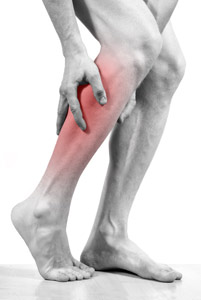
- Marks or indentations on the skin
- Redness, itching, or rashes on the skin
- Bad smell due to sweating
- Halted blood circulation (if the socks are too tight or have folds)
- Inflammation of joints and ankles
- Increase in swelling of the feet and ankles
- Allergic reaction to the material of the socks (cotton, elastane, lycra, merino wool, etc…)
- Corns, calluses, infections, or warts
These adverse effects may seem minor but can be potentially dangerous for the elder individual, so if you regularly use compression socks, using them properly is important.

Wearing compression socks can be somewhat complicated, at least for the elderly or those who are bedridden and have restricted mobility. Caregivers and nurses can help such individuals put on and take off their socks. Bed-bound seniors can also take the assistance of other family members or friends for wearing their compression garments.
Some tips for seniors regarding the use of compression socks
Compression socks can help you avoid partial loss of blood circulation, pain, itchiness, and redness of skin if you follow a few simple tips. These tips can also be followed by caretakers in nursing homes for the routine care of elder guests.
Use the correct size of compression socks for the elderly

The right size sock is important if the sock is to work correctly. Compression socks are different from regular socks and will lose their effectiveness if you use the incorrect size. Use accurate leg measurements and carefully select a pair for yourself using a size chart so that you get the right size that fits you perfectly.
Use the appropriate compression level
Compression socks can cause harm if the compression level selection is too high. Compression levels indicate how much pressure the sock will apply to your limbs. If the socks are loose, they will not prevent fluid accumulation, but if they are too tight, they can cause a loss of circulation in the legs. Both of these conditions can cause physical damage as well as discomfort.
Take care when wearing compression socks
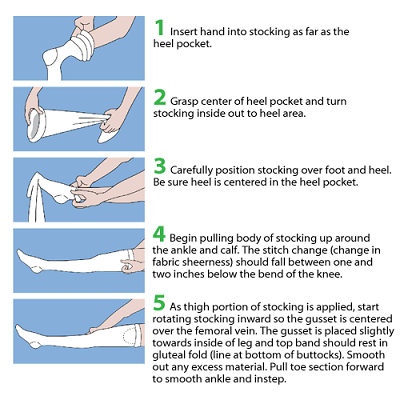
You must put on your socks with care. There should be no kinks, folds, or bundling of the fabric at any point. The ends of the sleeves or socks must not have folds as these may cause temporary indentations on the surface of the skin and may even cut off the blood supply to that part of the limb entirely.
These are not a splint. Your compression socks should feel smooth. They should give you more energy, not add to your pain.
Do not wear compression socks during sleep
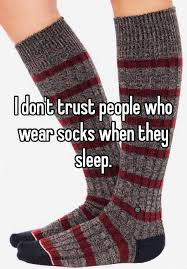
Elder individuals should be mindful of how long they wear their socks. You should take off your compression stockings before going to bed. You can wear them again first thing in the morning.
A gift for your grandparents and other elder family members

Compression socks are a perfect holiday present for your grandparents and other older family members. They’ve been featured in Forbes and Vagabond. Their importance is up there with smartphones, heart rate monitors, and improvements in nutrition.
Given their health benefits, they are particularly useful for those with joint or limb pain, and your loved ones will remember you every time they put on their favorite pair of stockings. However, to do things right, take into consideration a few important factors such as size, compression level, and length. The best thing you can do is order the same type of socks they already use, but if they do not currently use compression socks and you want to gift them a pair, you should be a little careful about what you are ordering.
Criteria for selecting compression socks for the elderly
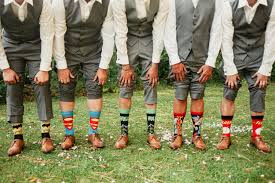
Compression socks are available in a variety of shapes, sizes, compression levels, and lengths. Shopping for compression socks for the elderly is not any different from buying items for any other age-group. However, you need to be more careful about:
- The length (knee-high or thigh-high) Configuration (sleeve, toeless, or closed-toe) Correct size (the exact measurement of the leg is necessary)
If you keep these factors in mind, you can never go wrong with your compression sock shopping, whether you are buying them in-store or ordering them online. We also realize that most people buy the color black. It might also help to know that compression socks are usually made in China or India. You don’t need a version Made in USA.
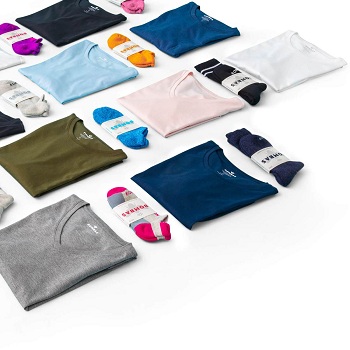
Compression socks may seem like a small piece of clothing, but they can help the elderly live a healthy life, both directly and indirectly. They reduce edema, prevent venous diseases, and relieve pain, while simultaneously allowing the elderly to walk, exercise, and socialize more easily, which will directly help them live happier, more fulfilling lives.
Where can you buy compression socks?
No need to head down to Walmart or get a doctor’s prescription. You can buy them online at the link below:
